Your Cart is Empty
90 Day Money Back Guarantee
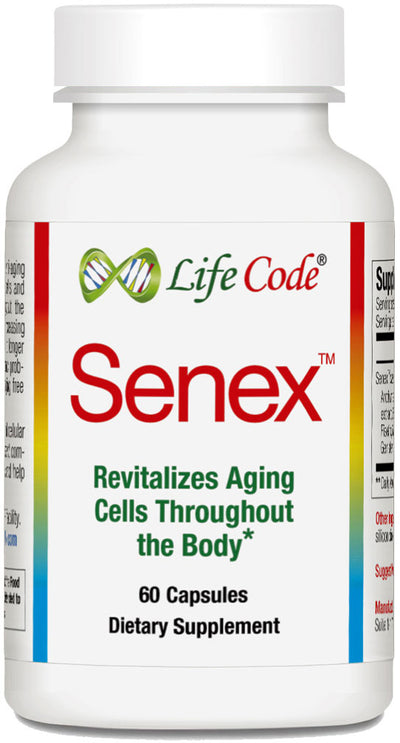
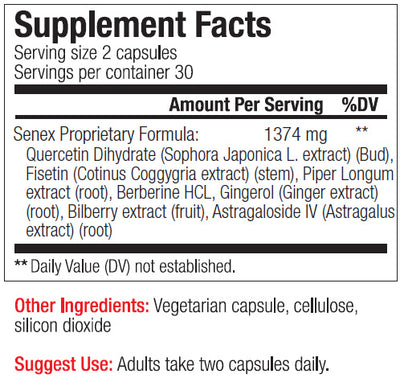
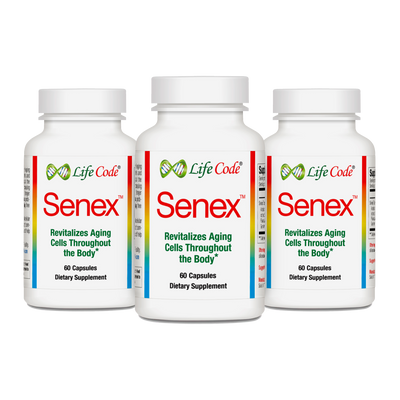
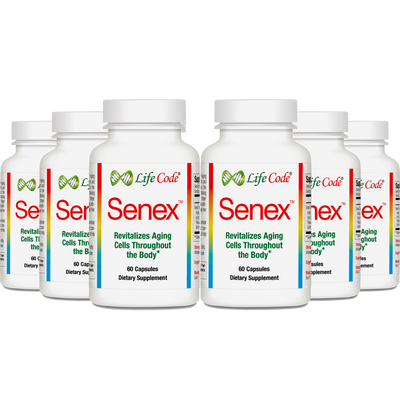




Sold Out
Natural Senolytic Supplement – A Revolutionary New Approach to Anti-Aging that Neutralizes Old Cells That Accumulate in Your Body
SenexTM is part of a new class of anti-aging nutraceuticals called Senolytics [1]. As we age we accumulate an increasing number of old worn out cells that are referred to as senescent. SenexTM helps keep senescent cells in check by slowing their formation, neutralizing their excreted toxins, and thwarting dysfunctional aberrant cells.
Cellular senescence occurs because most of the cells in the body decline in function and replicative capacity with age. Old senescent cells are a root cause of aging as they accumulate in the body and excrete free radicals, pro-inflammatory toxins, and damaging cytokines into the blood stream to damage surrounding healthy cells and organs system wide.
Senescent cells that accumulate with age can thus affect the rate of aging, the formation of aberrant cells, and overall health [2-5]. For example senescent cells have alternative RNA splicing that produce senescent toxins such as Progerin [6, 7], which degrades cell function and leads to other excreted cell toxins causing widespread systemic problems to your body. Moreover, senescent cells are more prone to act in an aberrant way and not perform their normally assigned function, which disrupts normal tissue and organ function.
SenexTM Acts on Senescent Cells to Help Revitalize Health and Promote Youthfulness
1. Attacks multiple root causes of aging* [8-11]
2. Neutralizes aberrant or senescent cells* [12-19]
3. Protects against Brain and neural damage* [20-31]
4. Promotes cardiovascular health* [32-40]
5. Protects against kidney, lung, and liver damage* [41-47]
6. Protects skin and promotes scar healing* [48-56]
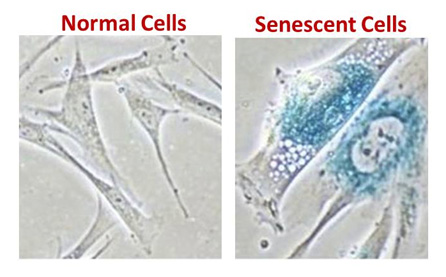
Senescent cells are dysfunctional cells that accumulate with age in all tissues and organs. These zombie cells can represent 10% - 20% of total cells in the elderly.
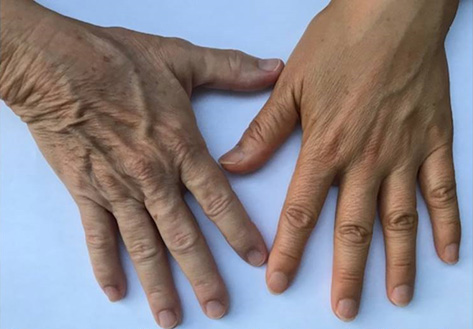
Senescent cells are a major factor in skin aging.
Senex Supplement Facts
*This products has not been approved by the FDA and is not intended to diagnose, prevent, treat, or cure any disease.
Serving Size: 1 Capsule
Servings Per Container: 30
Senex ingredients:
Fisetin (Cotinus coggygria Branch Extract) 200 mg
Liposomal Quercetin (Quercitin Dihydrate)
(Sunflower phospholipids) 110 mg
Liposomal Curcumin (Curcuma longa
Rhizome Extract)(Sunflower phospholipids) 71 mg
Berberine HCL 50 mg
Olive Leaf Extract 35 mg
Luteolin (Sophora japonica L. Bud Extract) 21 mg
Piperlongumine (Piper longum Fruit Extract) 10 mg
Apigenin (Citrus paradisi Fruit Extract) 10 mg
Gingerol (Zingiber officinale Rhizome Extract) 10 mg
Panex notoginseng Root Extract 5 mg
Other Ingredients: Vegetable capsule, cellulose, silicon dioxide
How many capsules should be taken per day?
Typical usage of SenexTM is two capsules per day. It is okay to take them both at the same time and with or without a meal.
Can children take SenexTM
We recommend SenexTM for adults over the age of 21. Those in their 20s and 30s will like the boost in endurance during sports or exercise, while older users will notice better energy, sleep and a more youthful appearance.
Does SenexTM contain natural ingredients?
SenexTM is made using a patent-pending combination of natural ingredients. The herbal components are natural herbs that are standardized for revitalize aging cells throughout the body. Everyone has aging cells, however older people have more.
Is this supplement recommended for pregnant or lactating individuals?
SenexTM is not recommended for pregnant or lactating individuals.
1. Xu M, Pirtskhalava T, Farr JN, Weigand BM, Palmer AK, Weivoda MM, Inman CL, Ogrodnik MB, Hachfeld CM, Fraser DG, et al: Senolytics improve physical function and increase lifespan in old age. Nat Med 2018.
2. Baar MP, Brandt RMC, Putavet DA, Klein JDD, Derks KWJ, Bourgeois BRM, Stryeck S, Rijksen Y, van Willigenburg H, Feijtel DA, et al: Targeted Apoptosis of Senescent Cells Restores Tissue Homeostasis in Response to Chemotoxicity and Aging. Cell 2017, 169:132-147 e116.
3. Frasca D: Senescent B cells in aging and age-related diseases: Their role in the regulation of antibody responses. Exp Gerontol 2018, 107:55-58.
4. Gao B, Lin X, Jing H, Fan J, Ji C, Jie Q, Zheng C, Wang D, Xu X, Hu Y, et al: Local delivery of tetramethylpyrazine eliminates the senescent phenotype of bone marrow mesenchymal stromal cells and creates an anti-inflammatory and angiogenic environment in aging mice. Aging Cell 2018, 17:e12741.
5. Nekrasov PV, Vorobyov VV: Dopaminergic mediation in the brain aging and neurodegenerative diseases: a role of senescent cells. Neural Regen Res 2018, 13:649-650.
6. Cao K, Blair CD, Faddah DA, Kieckhaefer JE, Olive M, Erdos MR, Nabel EG, Collins FS: Progerin and telomere dysfunction collaborate to trigger cellular senescence in normal human fibroblasts. J Clin Invest 2011, 121:2833-2844.
7. Hamczyk MR, Villa-Bellosta R, Gonzalo P, Andres-Manzano MJ, Nogales P, Bentzon JF, Lopez-Otin C, Andres V: Vascular Smooth Muscle-Specific Progerin Expression Accelerates Atherosclerosis and Death in a Mouse Model of Hutchinson-Gilford Progeria Syndrome. Circulation 2018.
8. Chang J, Rimando A, Pallas M, Camins A, Porquet D, Reeves J, Shukitt-Hale B, Smith MA, Joseph JA, Casadesus G: Low-dose pterostilbene, but not resveratrol, is a potent neuromodulator in aging and Alzheimer's disease. Neurobiol Aging 2012, 33:2062-2071.
9. Li YR, Li S, Lin CC: Effect of resveratrol and pterostilbene on aging and longevity. Biofactors 2018, 44:69-82.
10. Maher P: Modulation of multiple pathways involved in the maintenance of neuronal function during aging by fisetin. Genes Nutr 2009, 4:297-307.
11. Villeponteau B, Still YL: Treating multiple antiaging pathways improves health markers in open label clinical study. Translational Medicine Communications 2017, 2.
12. Bae S, Lim KM, Cha HJ, An IS, Lee JP, Lee KS, Lee GT, Lee KK, Jung HJ, Ahn KJ, An S: Arctiin blocks hydrogen peroxide-induced senescence and cell death though microRNA expression changes in human dermal papilla cells. Biol Res 2014, 47:50.
13. Lee KY, Kim JR, Choi HC: Genistein-induced LKB1-AMPK activation inhibits senescence of VSMC through autophagy induction. Vascul Pharmacol 2016, 81:75-82.
14. Liu Q, Xu X, Zhao M, Wei Z, Li X, Zhang X, Liu Z, Gong Y, Shao C: Berberine induces senescence of human glioblastoma cells by downregulating the EGFR-MEK-ERK signaling pathway. Mol Cancer Ther 2015, 14:355-363.
15. Perrott KM, Wiley CD, Desprez PY, Campisi J: Apigenin suppresses the senescence-associated secretory phenotype and paracrine effects on breast cancer cells. Geroscience 2017, 39:161-173.
16. Wang YN, Wu W, Chen HC, Fang H: Genistein protects against UVB-induced senescence-like characteristics in human dermal fibroblast by p66Shc down-regulation. J Dermatol Sci 2010, 58:19-27.
17. Zhang M, Cai S, Zuo B, Gong W, Tang Z, Zhou D, Weng M, Qin Y, Wang S, Liu J, et al: Arctigenin induced gallbladder cancer senescence through modulating epidermal growth factor receptor pathway. Tumour Biol 2017, 39:1010428317698359.
18. Zhao H, Halicka HD, Li J, Darzynkiewicz Z: Berberine suppresses gero-conversion from cell cycle arrest to senescence. Aging (Albany NY) 2013, 5:623-636.
19. Zhu X, Yue H, Guo X, Yang J, Liu J, Liu J, Wang R, Zhu W: The Preconditioning of Berberine Suppresses Hydrogen Peroxide-Induced Premature Senescence via Regulation of Sirtuin 1. Oxid Med Cell Longev 2017, 2017:2391820.
20. Abolaji AO, Ojo M, Afolabi TT, Arowoogun MD, Nwawolor D, Farombi EO: Protective properties of 6-gingerol-rich fraction from Zingiber officinale (Ginger) on chlorpyrifos-induced oxidative damage and inflammation in the brain, ovary and uterus of rats. Chem Biol Interact 2017, 270:15-23.
21. Chen CC, Hung TH, Lee CY, Wang LF, Wu CH, Ke CH, Chen SF: Berberine protects against neuronal damage via suppression of glia-mediated inflammation in traumatic brain injury. PLoS One 2014, 9:e115694.
22. Han Y, Zhang T, Su J, Zhao Y, Chenchen, Wang, Li X: Apigenin attenuates oxidative stress and neuronal apoptosis in early brain injury following subarachnoid hemorrhage. J Clin Neurosci 2017, 40:157-162.
23. Ma XL, Zhang F, Wang YX, He CC, Tian K, Wang HG, An D, Heng B, Liu YQ: Genistein inhibition of OGD-induced brain neuron death correlates with its modulation of apoptosis, voltage-gated potassium and sodium currents and glutamate signal pathway. Chem Biol Interact 2016, 254:73-82.
24. Nemetchek MD, Stierle AA, Stierle DB, Lurie DI: The Ayurvedic plant Bacopa monnieri inhibits inflammatory pathways in the brain. J Ethnopharmacol 2017, 197:92-100.
25. Prakash D, Sudhandiran G: Dietary flavonoid fisetin regulates aluminium chloride-induced neuronal apoptosis in cortex and hippocampus of mice brain. J Nutr Biochem 2015, 26:1527-1539.
26. Rastogi M, Ojha RP, Prabu PC, Devi BP, Agrawal A, Dubey GP: Prevention of age-associated neurodegeneration and promotion of healthy brain ageing in female Wistar rats by long term use of bacosides. Biogerontology 2012, 13:183-195.
27. Song J, Li N, Xia Y, Gao Z, Zou SF, Kong L, Yao YJ, Jiao YN, Yan YH, Li SH, et al: Arctigenin Treatment Protects against Brain Damage through an Anti-Inflammatory and Anti-Apoptotic Mechanism after Needle Insertion. Front Pharmacol 2016, 7:182.
28. He H, Guo WW, Xu RR, Chen XQ, Zhang N, Wu X, Wang XM: Alkaloids from piper longum protect dopaminergic neurons against inflammation-mediated damage induced by intranigral injection of lipopolysaccharide. BMC Complement Altern Med 2016, 16:412.
29. Wang H, Liu J, Gao G, Wu X, Wang X, Yang H: Protection effect of piperine and piperlonguminine from Piper longum L. alkaloids against rotenone-induced neuronal injury. Brain Res 2016, 1639:214-227.
30. Zheng L, Wang H, Ba YY, Liu HL, Wang M, Guo WW, Wu X, Yang H: [Protective effect of alkaloids from Piper longum in rat dopaminergic neuron injury of 6-OHDA-induced Parkinson's disease]. Zhongguo Zhong Yao Za Zhi 2014, 39:1660-1665.
31. Liu X, Zhang J, Wang S, Qiu J, Yu C: Astragaloside IV attenuates the H2O2-induced apoptosis of neuronal cells by inhibiting alpha-synuclein expression via the p38 MAPK pathway. Int J Mol Med 2017, 40:1772-1780.
32. Affuso F, Mercurio V, Fazio V, Fazio S: Cardiovascular and metabolic effects of Berberine. World J Cardiol 2010, 2:71-77.
33. Altavilla D, Crisafulli A, Marini H, Esposito M, D'Anna R, Corrado F, Bitto A, Squadrito F: Cardiovascular effects of the phytoestrogen genistein. Curr Med Chem Cardiovasc Hematol Agents 2004, 2:179-186.
34. Atteritano M, Marini H, Minutoli L, Polito F, Bitto A, Altavilla D, Mazzaferro S, D'Anna R, Cannata ML, Gaudio A, et al: Effects of the phytoestrogen genistein on some predictors of cardiovascular risk in osteopenic, postmenopausal women: a two-year randomized, double-blind, placebo-controlled study. J Clin Endocrinol Metab 2007, 92:3068-3075.
35. Cicero AF, Reggi A, Parini A, Morbini M, Rosticci M, Grandi E, Borghi C: Berberine and monacolin effects on the cardiovascular risk profile of women with oestroprogestin-induced hypercholesterolemia. High Blood Press Cardiovasc Prev 2014, 21:221-226.
36. Crisafulli A, Altavilla D, Marini H, Bitto A, Cucinotta D, Frisina N, Corrado F, D'Anna R, Squadrito G, Adamo EB, et al: Effects of the phytoestrogen genistein on cardiovascular risk factors in postmenopausal women. Menopause 2005, 12:186-192.
37. Dar A, Channa S: Bronchodilatory and cardiovascular effects of an ethanol extract of Bacopa monniera in anaesthetized rats. Phytomedicine 1997, 4:319-323.
38. Derosa G, D'Angelo A, Bonaventura A, Bianchi L, Romano D, Maffioli P: Effects of berberine on lipid profile in subjects with low cardiovascular risk. Expert Opin Biol Ther 2013, 13:475-482.
39. Derosa G, Maffioli P, Cicero AF: Berberine on metabolic and cardiovascular risk factors: an analysis from preclinical evidences to clinical trials. Expert Opin Biol Ther 2012, 12:1113-1124.
40. Hosono M, Takahira T, Fujita A, Fujihara R, Ishizuka O, Tatee T, Nakamura K: Cardiovascular and adenylate cyclase stimulant properties of NKH477, a novel water-soluble forskolin derivative. J Cardiovasc Pharmacol 1992, 19:625-634.
41. Murata I, Abe Y, Yaginuma Y, Yodo K, Kamakari Y, Miyazaki Y, Baba D, Shinoda Y, Iwasaki T, Takahashi K, et al: Astragaloside-IV prevents acute kidney injury and inflammation by normalizing muscular mitochondrial function associated with a nitric oxide protective mechanism in crush syndrome rats. Ann Intensive Care 2017, 7:90.
42. Basios N, Lampropoulos P, Papalois A, Lambropoulou M, Pitiakoudis MK, Kotini A, Simopoulos C, Tsaroucha AK: Apigenin Attenuates Inflammation in Experimentally Induced Acute Pancreatitis-Associated Lung Injury. J Invest Surg 2016, 29:121-127.
43. Chen RJ, Tsai SJ, Ho CT, Pan MH, Ho YS, Wu CH, Wang YJ: Chemopreventive effects of pterostilbene on urethane-induced lung carcinogenesis in mice via the inhibition of EGFR-mediated pathways and the induction of apoptosis and autophagy. J Agric Food Chem 2012, 60:11533-11541.
44. Qiu YY, Zhu JX, Bian T, Gao F, Qian XF, Du Q, Yuan MY, Sun H, Shi LZ, Yu MH: Protective effects of astragaloside IV against ovalbumin-induced lung inflammation are regulated/mediated by T-bet/GATA-3. Pharmacology 2014, 94:51-59.
45. Ravichandran N, Suresh G, Ramesh B, Siva GV: Fisetin, a novel flavonol attenuates benzo(a)pyrene-induced lung carcinogenesis in Swiss albino mice. Food Chem Toxicol 2011, 49:1141-1147.
46. Algandaby MM, El-Halawany AM, Abdallah HM, Alahdal AM, Nagy AA, Ashour OM, Abdel-Naim AB: Gingerol protects against experimental liver fibrosis in rats via suppression of pro-inflammatory and profibrogenic mediators. Naunyn Schmiedebergs Arch Pharmacol 2016, 389:419-428.
47. Khodayar MJ, Javadipour M, Keshtzar E, Rezaei M: Role of berberine against arsenic induced oxidative damage in isolated rat liver mitochondria. J Environ Biol 2016, 37:285-290.
48. Chen RJ, Lee YH, Yeh YL, Wu WS, Ho CT, Li CY, Wang BJ, Wang YJ: Autophagy-inducing effect of pterostilbene: A prospective therapeutic/preventive option for skin diseases. J Food Drug Anal 2017, 25:125-133.
49. Park KK, Chun KS, Lee JM, Lee SS, Surh YJ: Inhibitory effects of [6]-gingerol, a major pungent principle of ginger, on phorbol ester-induced inflammation, epidermal ornithine decarboxylase activity and skin tumor promotion in ICR mice. Cancer Lett 1998, 129:139-144.
50. Wu PY, Lyu JL, Liu YJ, Chien TY, Hsu HC, Wen KC, Chiang HM: Fisetin Regulates Nrf2 Expression and the Inflammation-Related Signaling Pathway to Prevent UVB-Induced Skin Damage in Hairless Mice. Int J Mol Sci 2017, 18.
51. Lin R, Chen H, Callow D, Li S, Wang L, Li S, Chen L, Ding J, Gao W, Xu H, et al: Multifaceted effects of astragaloside IV on promotion of random pattern skin flap survival in rats. Am J Transl Res 2017, 9:4161-4172.
52. Chen B, Li R, Yan N, Chen G, Qian W, Jiang HL, Ji C, Bi ZG: Astragaloside IV controls collagen reduction in photoaging skin by improving transforming growth factor-beta/Smad signaling suppression and inhibiting matrix metalloproteinase-1. Mol Med Rep 2015, 11:3344-3348.
53. Peng LH, Chen X, Chen L, Li N, Liang WQ, Gao JQ: Topical astragaloside IV-releasing hydrogel improves healing of skin wounds in vivo. Biol Pharm Bull 2012, 35:881-888.
54. Faber L, Kovac I, Mitrengova P, Novotny M, Varinska L, Vasilenko T, Kello M, Coma M, Kuruc T, Petrova K, et al: Genistein Improves Skin Flap Viability in Rats: A Preliminary In Vivo and In Vitro Investigation. Molecules 2018, 23.
55. Irrera N, Pizzino G, D'Anna R, Vaccaro M, Arcoraci V, Squadrito F, Altavilla D, Bitto A: Dietary Management of Skin Health: The Role of Genistein. Nutrients 2017, 9.
56. Terra VA, Souza-Neto FP, Frade MA, Ramalho LN, Andrade TA, Pasta AA, Conchon AC, Guedes FA, Luiz RC, Cecchini R, Cecchini AL: Genistein prevents ultraviolet B radiation-induced nitrosative skin injury and promotes cell proliferation. J Photochem Photobiol B 2015, 144:20-27.
This product, settled my internal issues with digestion, i’m Very pleased with the product. Debbie E
Seems to be addressing my health issues better than what doctor has given me in the past 10 yrs